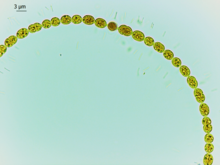Plants in the local flora with nitrogen-fixing symbionts
Ferns
Azollaceae, Azolla filiculoides hosts the photosynthetic and Nitrogen-fixing cyanobacterium Anabaena azollae. (Other hydrophytes are known to have extra-cellular symbionts, bacteria and archaea).
Anabaena azollae: Under nitrogen-limiting conditions, vegetative cells differentiate into heterocysts at semiregular intervals along the filaments. Heterocyst cells are terminally specialized for nitrogen fixation. The interior of these cells is micro-oxic as a result of increased respiration, inactivation of O2-producing photosystem (PS) II, and formation of a thickened envelope outside of the cell wall. Nitrogenase, sequestered within these cells, transforms dinitrogen into ammonia at the expense of ATP and reductant—both generated by carbohydrate metabolism, a process supplemented, in the light, by the activity of PS I. Carbohydrate, probably in the form of glucose, is synthesized in vegetative cells and moves into heterocysts. In return, nitrogen fixed in heterocysts moves into the vegetative cells, at least in part in the form of amino acids.[2] (Wikipedia) 
Angiosperms
Eudicots – Superrosids – Nitrogen-fixing clade
Order Fabales – Fabaceae (most). Rhizobium bacteria
– Polygalaceae (Rhinotropis: not known to have N-fixing symbiont)
Order Cucurbitales – Datiscaceae, Datisca glomerata. Frankia bacteria
Order Fagales – Betulaceae, Alnus rhombifolia. Frankia bacteria
Order Rosales – Rosaceae, Cercocarpus betuloides var. betuloides. Frankia bacteria
– Rhamnaceae, Ceanothus cuneatus var. cuneatus, Ceanothus oliganthus var. sorediatus. Frankia bacteria
Associative Nitrogen Fixation
Some grasses such including Digitaria spp. are known to have an Azospirillum association. We have no information on this grass/bacterial relationship at Jasper Ridge.
Azospirillum are able to form close associations with several members of the Poaceae (grasses), including agronomically important cereal crops, such as rice, wheat, corn, oats, and barley. These bacteria fix appreciable amounts of nitrogen within the rhizosphere of the host plants. Efficiencies of 52 mg N2 g-1 malate have been reported (Stephan et al. 1979). The level of nitrogen fixation is determined by several factors, including soil temperature (Azospirillum species thrive in more temperate and/or tropical environments), the ability of the host plant to provide a rhizosphere environment low in oxygen pressure, the availability of host photosynthates for the bacteria, the competitiveness of the bacteria, and the efficiency of nitrogenase (Vlassak & Reynders, 1979) -- Biological Nitrogen Fixation (www.nature.com)
References
- Biological Nitrogen Fixation (www.nature.com)
- Azospirillum, a free-living nitrogen-fixing bacterium closely associated with grasses: genetic, biochemical and ecological aspects
- Frankia, from Wikipedia, the free encyclopedia
- Rhizobium, from Wikipedia, the free encyclopedia



